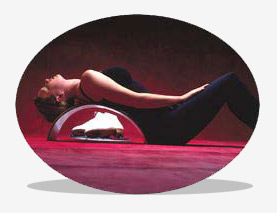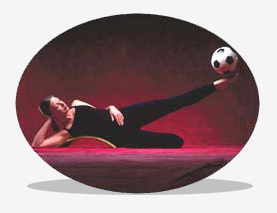
The Heath Bridges Story


It all began when two health care professionals observed an alarming and growing trend among their patients. Chiropractor Dr. Kenneth Beatty BSc., D.C. and back care specialist Ethne Munden R.N., Dr.Ac., C.Y.T both observed increasing numbers of patients with some type and degree of postural distortion.
Postural distortion is a clinical term that describes a variety of misalignments of the body. The work of Beatty and Munden has dealt primarily with distortion of the pelvis, back and shoulders.
 Although we often fail to see it in ourselves, these problems are easy to recognize in others. Rounded upper back, forward sloping shoulders and head angled forward are all telltale signs of postural distortion. Even the common, mild form of "poor posture" can diminish self-confidence and self-esteem. Unless corrected, these conditions can lead to greater degrees of postural distortion and can have an impact upon a person's physical health and wellbeing.
Although we often fail to see it in ourselves, these problems are easy to recognize in others. Rounded upper back, forward sloping shoulders and head angled forward are all telltale signs of postural distortion. Even the common, mild form of "poor posture" can diminish self-confidence and self-esteem. Unless corrected, these conditions can lead to greater degrees of postural distortion and can have an impact upon a person's physical health and wellbeing.
Cases of postural distortion and poor posture were becoming so commonplace as to be "the norm" among Beatty's and Munden's patients. In response to this growing problem, they began searching for a solution. They applied different professional backgrounds and perspectives - his in biomechanics and hers in yoga - in approaching the problem, yet they arrived at a similar conclusion. They developed Health Bridges, an orthopedic device that is so effective, it is now being marketed commercially across North America and around the world.
 On the one hand, Health Bridges is new and unique. On the other, it has been in development for several thousand years. That's because the doctors' research focused on "yoga props," devices of various shapes used to support and correctly position the body to derive maximum benefit from a pose or exercise. These props were often used by people with physical misalignments, in the same way that lower back supports help many of today's office workers perform at the keyboard for longer periods of time. Usually improvised from whatever materials were available, yoga props have been in use for thousands of years.
On the one hand, Health Bridges is new and unique. On the other, it has been in development for several thousand years. That's because the doctors' research focused on "yoga props," devices of various shapes used to support and correctly position the body to derive maximum benefit from a pose or exercise. These props were often used by people with physical misalignments, in the same way that lower back supports help many of today's office workers perform at the keyboard for longer periods of time. Usually improvised from whatever materials were available, yoga props have been in use for thousands of years.
Beatty and Munden agreed that the most common symptoms of poor posture - sloping shoulders and rounded upper back - could be relieved through opposing force; that is, through expansion of the chest area. There's a simple exercise that demonstrates this principle. Are you slumped forward now, as you read this text? Then inhale a chest full of air, lift your shoulders and tuck in your stomach. Now that's good posture! Only problem is, most of us fall back into the slump as quickly as we exhale our breath. The challenge was to bring about prolonged expansion of the chest. In striving for this goal, the doctors explored the possibilities of a yoga prop known as " the whale" or "the bridge." Both names describe the curved shape of the device, which was placed under the back during yoga exercises. One unmistakable effect of "the bridge" was a pronounced expansion of the chest cavity.
Beatty and Munden suspected that this effect could be prolonged - and posture improved - through regular use of an improvised and updated version of "the bridge." With some help from the National Research Council, Industrial Research Assistance Program, they designed a set of three prototype devices that worked as a set. Patients use the three devices to move gradually from beginner, to intermediate and finally to the advanced level, as flexibility of the back increases. One key innovation was a slot up the centre of the bridges, which eliminates pressure on the spinal column and evenly distributes body weight across the muscles of the back. As well, the base of the bridges has been widened for stability and the upper end narrowed to allow for easier chest expansion. A rubber mat is recommended to prevent slippage of the device during use.
 To use the bridge, patients place the device curved side up on the non-slip mat on the floor. Then they sit on the floor with their backs to the bridge, with the buttocks touching the bridge where the centre slot is lowest, and lower themselves carefully back over the device, making sure the spinal column falls into the centre slot. That's all there is to it!
To use the bridge, patients place the device curved side up on the non-slip mat on the floor. Then they sit on the floor with their backs to the bridge, with the buttocks touching the bridge where the centre slot is lowest, and lower themselves carefully back over the device, making sure the spinal column falls into the centre slot. That's all there is to it!
Clinical trials of Health Bridges, as part of an overall therapeutic program, proved the doctors' theory; that repeated use of the bridges (10 minutes per session, two sessions per day) did indeed expand the chest, lift the shoulders and bring about long-term improvements to posture. Health Bridges, when used under the supervision of health care professionals, can help to correct poor posture and reduce postural distortion.
Beatty and Munden also noted that the Health Bridge was more than simply a posture corrector; it was a device integral to the pursuit and maintenance of overall physical health and well-being. It didn't require drugs or strenuous exercise. Health Bridges were easy to use and most everyone could benefit from them. In short, they deserved to be in everyone's home.
 To back up their findings, the Health Bridges development team had their research reviewed and the device tested by several health care professionals at the 33rd annual Congress of Alternative Medicine in Edmonton, Alta., during April, 1995. Without exception, Health Bridges were warmly received by professionals from all over the world. Work began in earnest to manufacture and market Health Bridges to consumers across North Amercia, and eventually, the world.
To back up their findings, the Health Bridges development team had their research reviewed and the device tested by several health care professionals at the 33rd annual Congress of Alternative Medicine in Edmonton, Alta., during April, 1995. Without exception, Health Bridges were warmly received by professionals from all over the world. Work began in earnest to manufacture and market Health Bridges to consumers across North Amercia, and eventually, the world.
What Health Bridges would be made of and how they would be manufactured were important questions. Beatty and Munden decided against mass production with cheap materials. Health Bridges are hand-crafted and finished from the finest quality Birch hardwood, and could easily be mistaken for fine, contemporary furniture.
Health Bridges are sold separately or as a set of three. Each come with complete instructions and available accessories include an attractive, sturdy, canvas carrying bag with distinctive rope handles, a bolster sleeve which can be stuffed and used as a beginner bridge or to relieve pressure on the head, neck or lower back, a sure-grip mat, and an instructional video. As with any orthopedic device, first time users are strongly advised to check with their health care professionals before using Health Bridges.
Do you have persistent back problems or poor posture? If so, Health Bridges can probably help. They are boldly new and thoroughly unique. They are a natural, proven remedy that has been in development for several thousand years. We welcome you to take your first step on "Health Bridges" for better health and physical and emotional well being.
Don't hestitate to contact us, we would be happy to explain or demo our product in person.
47 Leslie Street
St.John's, NF A1E 2V7
Phone: 1-709-738-5908
Fax: 1-722-5527